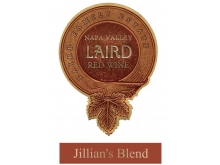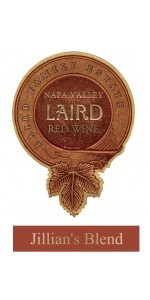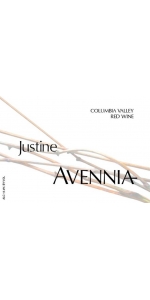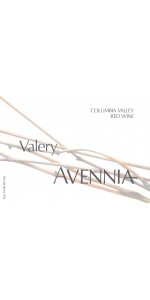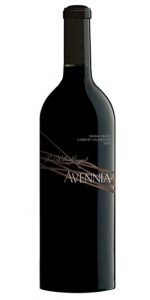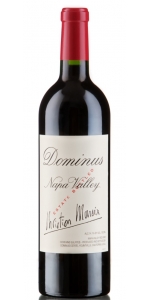Laird Jillians Red Blend 2016
| Country: | United States |
| Regions: | California California (Napa) |
| Winery: | Laird |
| Grape Type: | Cabernet Sauvignon |
| Organic: | Yes |
| Vintage: | 2016 |
| Bottle Size: | 750 ml |
Laird Jillians Red Blend is made from 65% Cabernet Sauvignon, 18% Syrah, 10% Merlot, 5% Malbec and 2% Petit Verdot
21 months in 75% French Oak and 25% American Oak (40% new and 60% neutral)
Vineyard: Cabernet Sauvignon (60% Mast Ranch + 40% Linda Vista Ranch), Syrah (100% Eagle Vines Ranch), Merlot (100% Big Ranch), Malbec (100% Flat Rock Ranch) and Petit Verdot (100% Flat Rock Ranch).
Appellation: Napa Valley
Our family has been proudly growing grapes in Napa Valley for two generations; this unique fusion of four varietals honors the youngest member of the third generation in our farming family, our daughter Jillian. This Left Bank Bordeaux-style blend with a twist of Rhone is structured, but easy to drink. Jillian’s is the only blend we make and it’s our most popular red wine.
Tasting Notes: Complex and precocious just like the real Jillian. Its deep, ruby red appearance accompanied by viscous legs leads the way to a seductive bouquet of toasted oak, lavender and ripe strawberries. A medium bodied palate, with delicate tannins and acidity, leads the way to tart dusty cherries and boysenberries that dance across your palate, while flavors of clove, vanilla and blueberry custard unfold on the finish.
Avennia Justine Red Blend 56% Grenache, 31% Mourvèdre, 13% Syrah
Justine reflects our belief that Washington is capable of producing world class blends of grape varieties traditional to the Southern Rhone region of France. The name is inspired by one of the great heroines of recent literature, who also sprung from the imagination of the Mediterranean. Dark, seductive, complex, with a chasm of depth: The Justine is a great reflection of Avennia's mission of expression, and Washington's generous terroir.
Tasting Note: Big black cherry, blackberry, hints of orange peel, fresh herbs and loam on the nose. Plush and round on the palate. Dark earthy fruits from the Mourvedre, along with citrus high notes, mountain flowers, jasmine, and savory herbs. Balanced and complex without forgetting its hedonistic roots in the Southern Rhone.
Review:
A blend of 56% Grenache, 31% Mourvèdre, 13% Syrah brought up all in older oak, the 2016 Justine offers a great core of black fruits as well as lots of peppery herbs, earth, and classic meatiness. It looks to be a great vintage for this cuvée."
- Jeb Dunnuck (April 2018), 92-94 pts
Avennia Valery Red Blend is made from 86% Merlot and 14% Cabernet Franc
Valery is named for the patron saint of wine in the St. Emilion region that inspired it.
We started with old vine Merlot from a stony block in the heart of the Yakima Valley and added complex, aromatic Cabernet Franc from the Horse Heaven Hills. The result is a balanced, complex wine with the elegance and ethereal perfume that this blend of two of Washington’s best varietals are known for.
The nose on this wine is very perfumed, almost exotic with notes of fresh violets, red plum, winter mint, fresh herbs and crushed limestone qualities. The palate is poised and balanced, with red fruits and mocha powder encapsulated in limestone. The finish lingers delicately, with the Cabernet Franc asserting a light tobacco and herb note, giving depth. A compelling wine that will continue to unwind for 7-10 years in the cellar.
Review:
"Brought up in 30% new French oak, the 2016 Valery (70/30 Merlot and Cabernet Franc) offers more black cherry and earthy, herbal notes as well as a medium-bodied, seamless, beautifully balanced style. It too shows a vibrant, fresh, yet concentrated style that has a Bordeaux feel in its weight and texture."
- Jeb Dunnuck (April 2019), 93 pts
"Good medium-dark red. Aromas of blueberry, mocha, licorice and violet are a bit darker than those of the 2015 version. Dense and penetrating, with wild flavors of dark berries, licorice and game given lift by rocky minerality and a minty nuance. Chris Peterson slightly acidified his Cabernet Franc from Champoux Vineyard, which he added to the wine for richness. This beauty may yet tighten up in the bottle.- Stephen Tanzer"
- Antonio Galloni's Vinous (November 2018), 92+ pts
Avennia Red Willow Cabernet Sauvignon is made from 100% Cabernet Sauvignon.
The Red Willow Cabernet is a true blockbuster.
Coming from one specific block of 30 year old vines at this iconic vineyard, then strictly barrel selected, this is the essence of powerful, old vine Washington Cabernet. After all of our efforts promoting the idea of the Bordeaux blend, it would take a pretty compelling argument to suspend that idea and make a 100% varietal Cabernet. In 2016 Red Willow provided us with just that. Each time we tasted it in the barrel, the belief grew that this was something special. Something we can't make every year. In the end we were won over, and decided to make a limited amount of this wine. But don't be fooled, as this too is a blend and a selection. Each year as we are tasting the grapes as harvest approaches, we notice that the vines near the bottom of this long, steep west-facing slope, are a little different. The vines at the bottom are in a little richer soil, and get a little more water, so we pick them separately, sometimes even a week or ten days apart, and keep them separate in barrel.
This wine is all from the top of the vineyard, with its lower yield and poorer soils giving more concentration and interest. Then further, nearly every combination of new and used French oak barrels were trialed to find the best blend. It's not enough just to use the four best barrels, but to trial each combination to see how they complement each other. For a wine with this much mass, 100% new French oak was used for the first time at Avennia. It is a wine that needs a little cellaring to start, but should last a very long time.
Review:
Made from 100% Red Willow Cabernet Sauvignon, the 2016 Cabernet Sauvignon Red Willow is another gem from this great winemaker. Deep purple-colored, with a huge perfume of blackberries, crème de cassis, cedarwood, pencil lead, and graphite, it hits the palate with medium to full-bodied richness and depth, nicely integrated acidity, and building, ripe tannins. Give bottles 3-4 years and it too will cruise for 15-20 years or more.
- Jeb Dunnuck (April 2019), 95 Points
Bursting from the glass with impeccable precision, the 2016 Cabernet Sauvignon Red Willow Vineyard is the real McCoy, boasting a focused frame of fruit on the nose that shows depth and breadth in layers of aromas—blackberry, dark cherry, licorice and clove-laced spices flutter over a bed of roses. I can't stop smelling this wine! Full-bodied, the wine unfolds and expands across the palate with complexity, tight structure and beautifully managed tannins, ending with a thought-provoking and long-lingering finish. The wine has a still-tight expression that will age beautifully for years to come. It will serve you well to seek out a bottle of this world-class wine. Only 140 cases were made.
- Wine Advocate 95 Points
Avennia Red Willow Cabernet Sauvignon is made from 100% Cabernet Sauvignon.
The Red Willow Cabernet is a true blockbuster.
Coming from one specific block of 30 year old vines at this iconic vineyard, then strictly barrel selected, this is the essence of powerful, old vine Washington Cabernet. After all of our efforts promoting the idea of the Bordeaux blend, it would take a pretty compelling argument to suspend that idea and make a 100% varietal Cabernet. In 2016 Red Willow provided us with just that. Each time we tasted it in the barrel, the belief grew that this was something special. Something we can't make every year. In the end we were won over, and decided to make a limited amount of this wine. But don't be fooled, as this too is a blend and a selection. Each year as we are tasting the grapes as harvest approaches, we notice that the vines near the bottom of this long, steep west-facing slope, are a little different. The vines at the bottom are in a little richer soil, and get a little more water, so we pick them separately, sometimes even a week or ten days apart, and keep them separate in barrel.
This wine is all from the top of the vineyard, with its lower yield and poorer soils giving more concentration and interest. Then further, nearly every combination of new and used French oak barrels were trialed to find the best blend. It's not enough just to use the four best barrels, but to trial each combination to see how they complement each other. For a wine with this much mass, 100% new French oak was used for the first time at Avennia. It is a wine that needs a little cellaring to start, but should last a very long time.
Review:
"The 2016 Cabernet Sauvignon Red Willow Vineyard is 100% Red Willow Cabernet Sauvignon that will spend roughly 20 months in close to 100% new French oak. Blackcurrants, smoked herbs, chocolate, and graphite notes all give way to a full-bodied, plump, rich, concentrated effort that's going to be better with short-term cellaring and keep for two decades."
- Jeb Dunnuck (April 2018), 94-96 pts
Dominus Napa Valley Red Blend is made from 88% Cabernet Sauvignon, 7% Cabernet Franc, 5% Petit Verdot.
The historic Napanook Vineyard, a 124-acre site west of Yountville, was planted in 1838. This vineyard was the source of fruit for some of the finest Napa Valley wines. Estate-bottled in the spirit of the Bordeaux châteaux, Dominus Estate is dry-farmed to allow natural stress and good concentration of fruit. Grape clusters are crop-thinned to allow sun and air to pass in between, helping to achieve full maturation and soften the tannins. Only 20% to 40% new French oak barrels are used in order to limit the extraction of oak notes. To express the unique terroir, the classic Bordeaux grape varietals of Cabernet Sauvignon, Merlot, Cabernet Franc and Petit Verdot are planted with different root stocks best suited for the varying soil composition of gravel, heavy clay and loam.
Reviews:
One of the legendary Dominus, the 2021 Cabernet Sauvignon is unquestionably in the same league as the 2018, 2016, 2015, 2013, 2010, and 1991, and to my mind, wine simply doesn't get any better. Sporting a dense purple hue as well as an incredible perfume of blackcurrants, crushed stone, cedar pencil, smoke tobacco, and baking spices, it s rich, full-bodied, and voluptuously textured, with ripe yet building tannins. It reminds me slightly of the 2010 (maybe the 2013), and I suspect it will have a similar evolution. Hide bottles for 7-8 years, and it will evolve gracefully for 30+ years. Hats off to the team of Christian Moueix and director Tod Mostero.
Jeb Dunnuck 100 Points
Laird Jillians Red Blend is made from 65% Cabernet Sauvignon, 18% Syrah, 10% Merlot, 5% Malbec and 2% Petit Verdot
21 months in 75% French Oak and 25% American Oak (40% new and 60% neutral)
Vineyard: Cabernet Sauvignon (60% Mast Ranch + 40% Linda Vista Ranch), Syrah (100% Eagle Vines Ranch), Merlot (100% Big Ranch), Malbec (100% Flat Rock Ranch) and Petit Verdot (100% Flat Rock Ranch).
Appellation: Napa Valley
Our family has been proudly growing grapes in Napa Valley for two generations; this unique fusion of four varietals honors the youngest member of the third generation in our farming family, our daughter Jillian. This Left Bank Bordeaux-style blend with a twist of Rhone is structured, but easy to drink. Jillian’s is the only blend we make and it’s our most popular red wine.
Tasting Notes: Complex and precocious just like the real Jillian. Its deep, ruby red appearance accompanied by viscous legs leads the way to a seductive bouquet of toasted oak, lavender and ripe strawberries. A medium bodied palate, with delicate tannins and acidity, leads the way to tart dusty cherries and boysenberries that dance across your palate, while flavors of clove, vanilla and blueberry custard unfold on the finish.
After nearly 50 years in the wine business, we understand the ins and outs of the industry, from the trends to the challenges. We believe that our success is due to our vineyard expertise as well as our shared goal to produce great estate wines.
With a concentration on Napa and Carneros vineyards, we have sought to produce wines that are “a window to a place.” Each one of our vineyards is different in expression, with its own subtle, yet distinctive character and voice. Each year renews in us an intense drive to understand, react to, and work with each vineyard to allow it to reach its full potential. This process, lead by our winemaking and vineyard management team, is crucial for the execution of successful wines.
With a concentration in Napa and Carneros vineyards, we have sought to produce wines that are “a window to a place.” Each one of our vineyards is different in expression: each has a subtle, yet distinctive vineyard voice. With every year there is an intense drive to understand, react to and work with each vineyard to reach its full potential. This process, lead by winemaker and vineyard manager, is crucial for the execution of successful wines.
While growing up to be a big city mechanical engineer in New York City, Ken held on to his family tradition of becoming a farmer. In 1970, Ken and his wife, Gail, purchased their first Napa Valley parcel. This neglected piece of land, adjacent to Tubbs Lane in Calistoga, held 70 acres of worn-down prune trees. With Prohibition forty years gone and Napa Valley positioned to re-emerge as viticulturally significant, Ken and Gail decided to develop the orchard into a grape vineyard. While knowing just short of nothing about viticulture, they were also $150,000 short to properly develop the orchard into a respectable vineyard. Picking up a tattered phone book, Ken went to the yellow pages and found eight listed wineries…Robert Mondavi being the only one he recognized.
With a phone call, Robert Mondavi himself agreed to walk the property. After they discussed soils, vines, yields, irrigation, and proper pruning, Robert agreed to finance a deal with the Lairds if they would plant 50% Gamay. The deal was struck with a resulting vineyard of 50% Gamay and 50% Cabernet Sauvignon. Mr. Mondavi guaranteeing the Laird’s Cabernet “to be the highest harvest price paid in the Valley.” The support and encouragement of Robert Mondavi would allow Ken to return to his passion: his family farming heritage.
By the late 1990’s the Laird vineyard holdings had exceeded 2,000 acres and the idea of making their own premium line of wines began to take shape. Architect, Jon Lail, showed Ken and Gail the plans for the iconic pyramid-shaped, multi-level winery. Construction began on what would become the Red Hen Ranch vineyard property north of Napa. Ken and Gail’s son, Justin, worked side-by-side with Ken in the vineyards and became the Vineyard Manger, while their daughter, Rebecca, became the General Manager of the winery. Rebecca’s daughter, Jillian, was born in 2005, the same year the winery’s first red blend was produced, appropriately named Jillian’s Blend (and it happens to be Laird Family Estate’s most popular wine). Justin’s daughter, Megan, works in finance in New York City. His son, David, is continuing the family’s farming legacy by working with his dad in the vineyards.
The vineyard holdings possess a cross section of geomorphic and microclimate idiosyncrasies that are poised to produce particular grape varieties that thrive in their desired terroir.
From the thick fog and marine winds in Carneros to the volcanic soils mixed with ancient coastal deposits in the lower bench of the Mayacamas Mountains, they farm their vineyards to produce fruit that best complements the hallmarks of the land.
- back
All older vintage wines have been purchased from a single collectors cellar. Pictures can be requested before shipment.
Siegel Naranjo Orange Wine Viognier is made from 100% Viognier.
This wine has a nice gold color with some pink hues. On the nose, it shows some sweet notes of spices, dry nuts, white flowers, as well as some light notes of huesillo (dry peaches). In the mouth it shows a beautiful acidity, with a nice mouthfeel and structure and a good length to the finish.
Pair with rich fish and meat dishes, cheeses, appetizer and dessert.

